Table of Contents
Neonatal or Newborn Reflexes
- Palmar Grasp
- Plantar Grasp
- Moro reflex
- Startle reflex
- Rooting and Sucking reflex
- Asymmetric tonic neck reflex
- Symmetric tonic neck reflex
- Walking/Stepping reflex
- Babinski’s reflex
- Landau reflex
- Parachute reflex
- Gallant reflex (trunk incurvation)
1. Palmar Grasp
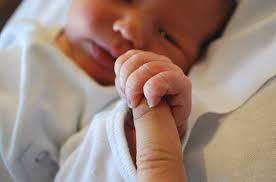
- With the baby supine and head in midline, stroke baby’s palm with examiner’s finger, the baby’s finger closes and grasps the stroking finger.
- It is almost strong enough to support the weight of the baby when pulled
- It is present at birth and disappears by 3 months
2. Plantar Grasp
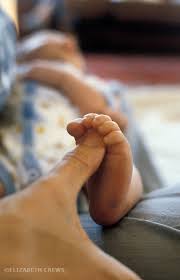
- Press the examiner’s fingers on the anterior sole of the baby, the foot tends to move as though to close.
- It presents at birth and disappears by 7 -9 months
3. Moro Reflex
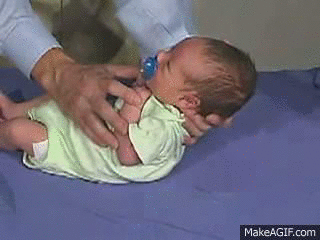
- It is elicited best by the sudden dropping of the head in relation to the trunk and catching the falling head
- The response consists of:
- Opening of hands (by 28 weeks of gestation)
- Extension and abduction of upper extremities (by 32 weeks)
- Anterior flexion of upper extremities (by 37 weeks)
- Audible cry
- Moro reflex disappears by 3 – 4 months in most normal infants
- It is a very sensitive indicator of an infant’s level of alertness
Depressed or absent Moro indicates generalized depression of the CNS.
- Bilateral exaggerated hung up Moro is found in Kernicterus
4. Startle reflex
It is different from Moro, Here a sudden loud noise produces a Moro-like movement, but unlike Moro, elbows remain flexed(not extended as in Moro) and hands remain closed
5. Rooting & Sucking Reflex
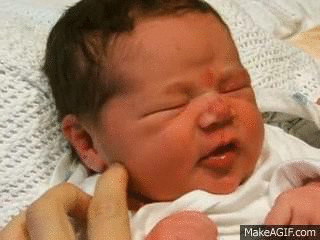
Nipple or finger in baby’s mouth elicits sucking, if nipple or finger contacts to the cheek, the infant turns towards it seeking the nipple to suck (Rooting)
6. Asymmetric tonic neck reflex
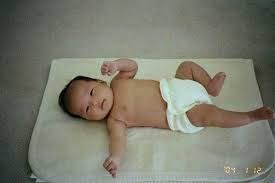
- With the baby supine, rotate the head to one side, there is an increase in tone resulting in an extension of the arm and leg on the side the head is turned and the opposite side bends
- It is most easily elicitable during 2 – 4 months of age
- It is also known as fencing reflex
- It disappears by 4 – 6 months
7. Symmetric tonic neck reflex

- On extending the neck, the upper limb extends and lower limb flexes
- It is also known as fencing reflex
- In cerebral palsy this reflex is overactive so that when the child tries to get up from prone position, it cannot, as the leg remains obligatorily flexed, the child can extend the leg only if the neck is flexed
8. Walking/Stepping reflex
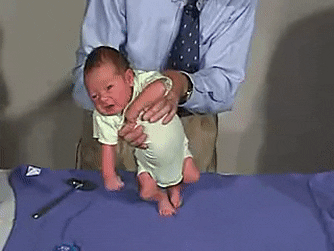
- The walking or stepping reflex is present at birth, though infants this young cannot support their own weight.
- When the sole of their feet touches a flat surface they will attempt to walk by placing one foot in front of the other.
9. Babinski’s reflex
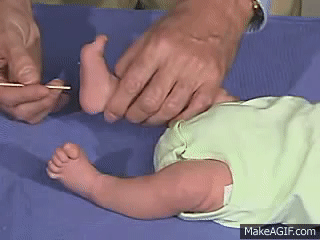
- A gentle stroke on the sole of the foot from the heel to toe, the foot turns in and toes flare-up
- It appears at birth and lasts until the baby is 6 to 24 months old
10. Landau reflex
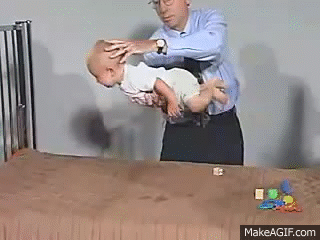
- When the baby is held in ventral suspension, the head, spine, and legs must extend normally
- When the head is flexed by the examiner, the hip, knee, and elbow should flex. This reaction is normally present from 3 -12 months
- The absence of this reflex beyond 3 months of age may indicate motor weakness.
11. Parachute reflex
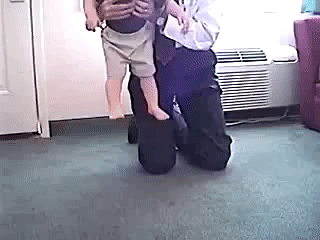
- This appears by 6 – 9 months and persists throughout life.
- Hold the child in ventral suspension and suddenly lower him to the couch. The arms extend as if to protect him from falling
- In cerebral palsy, it may be absent or incomplete due to abnormalities of tone
12. Gallant’s reflex (trunk incurvation)
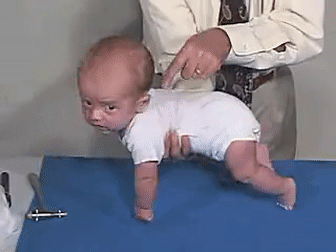
- Elicited by holding the infant in horizontal in a prone position on a flat surface, and running the finger down the paravertebral area on one side. The response is swinging of the pelvis towards the stimulated side
- It usually disappears by one year of age
- Clinical value is in mapping sensory level on the trunk, sensation may be absent in some spinal cord disorder below the level of the lesion.
Medical and Surgical Nursing Questions and Answers – Defense Mechanism